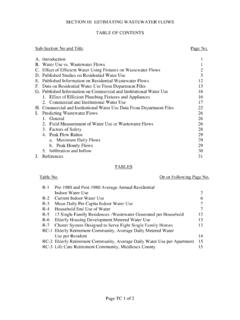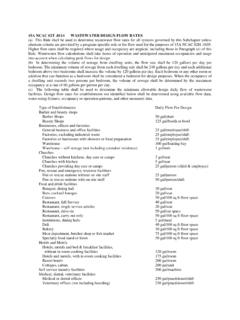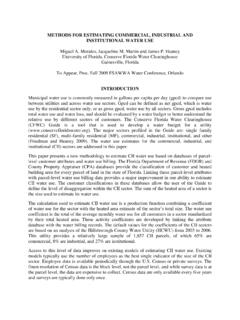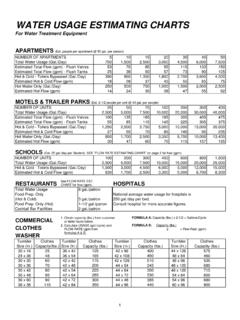Transcription of How to Estimate the Cost of a Temporary Site Dewatering …
1 How to Estimate the Cost of a Temporary site Dewatering system By: Basana Allah June 15, 2012 2 How to Estimate the Cost of a Temporary site Dewatering system Table of Contents Section 1 Introduction Page 3 Section 2 Types and Methods of Measurement Page 5 Section 3 Specific Factors to Consider Affecting Takeoff and Pricing Page 7 Section 4 Overview of Labor, Material, Equipment, and Indirect Costs Page 8 Section 5 Special Risk Considerations Page 10 Section 6 Ratios and Analysis Page 12 Section 7 Miscellaneous Pertinent Information Page 13 Section 8 Sample Sketch Page 14 Section 9 Sample Takeoff and Pricing Page 16 Section 10 Glossary Page 17 Section 11 References Page 17 Section 12 Signed Copy of Paper Topic Approval Letter Page 18 3 Section 1 - Introduction It is the intent of this technical paper to give the reader a basic understanding of a typical Temporary site Dewatering system and illustrate
2 To an estimator how to determine the anticipated cost of the system . Generally speaking, Dewatering is defined as the process of removing water from a given condition. Specifically as it relates to construction, Temporary Dewatering involves lowering the water table and intercepting water seepage which would otherwise emerge from the faces or bottom of an excavation. There are several different methods that can be utilized to achieve Temporary Dewatering . Some of the most common systems currently in use include wellpoints, deep wells, eductors, ground freezing, or a combination of these or other custom systems.
3 The determination of what system to use is project specific and depends on several factors including the type of soils at the site , the soil permeability, the depth of the groundwater, the required excavation depth, and the physical constraints of the site . Wellpoint Dewatering systems are one of the most versatile and commonly used systems and will be the main focus of this technical paper. Main CSI Division (Construction Specifications Institute 2004 Master Format) Division 31 Earthwork Main CSI Subdivisions (Construction Specifications Institute 2004 Master Format) Subdivision 31 23 19 Dewatering Brief Description Groundwater often exists at various depths below the existing ground level.
4 When the need arises to conduct construction activities at depths below the existing water table, a Temporary site Dewatering system can be used to lower the water table to allow work to be done in a dry environment. Some of the most common construction activities that may require Dewatering include excavations for basements, deep foundations, or underground utilities. A basic wellpoint 4 Temporary Dewatering system consists of a series of small vertical wells (called wellpoints) around a given excavation area.
5 The wells are connected at the surface level to a continuous header pipe, which is then connected to one or more pumps. The vacuum effect created by the system s pump will draw water from the wellpoints thereby lowering the level of the groundwater in the area requiring Dewatering . A discharge line connected to the pump is the means by which the generated groundwater is expelled to a suitable collection area. A single wellpoint system can be used at depths up to about 22 feet. However, for deeper excavations, multiple wellpoint systems can be used together in a stepped or benched fashion.
6 On most construction projects, a specific Dewatering method is not a part of the project architect s design, but rather the general contractor is responsible for selecting the most appropriate Dewatering system for the particular project. In such cases, the general contractor is responsible for designing, furnishing, installing, operating, maintaining, and removing the Temporary Dewatering system as required to lower and control water levels and hydrostatic pressures during construction activities.
7 The general contractor must also determine whether the pumped water can effectively be contained on- site or whether it will need to be disposed of off- site , as well as whether or not the pumped water will need to be treated. The Estimate included in this paper will assume that the pumped water will be untreated and will be contained on site . In many locations around the country, the control of groundwater during construction is a very common practice. Yet, despite its common occurrence, Dewatering can be a complicated process depending on the site conditions and the excavation requirements.
8 While it is not uncommon for a general contractor to make the choice to self-perform Dewatering operations, this technical paper will approach the estimated cost from the point of view of a specialty Dewatering subcontractor. Typically, the Dewatering subcontractor will include the cost of 5 designing and engineering the system in their overall cost. However, the Estimate presented in this paper will assume that the system is already designed and will therefore not address any design or engineering costs.
9 Section 2 - Types and Methods of Measurement Before the estimator begins his takeoff for the Dewatering system , he should become very familiar with the requirements of the system by reviewing all of the project documents and paying special attention to the Dewatering plan (typically depicted on a site plan with supporting details), as well as the specifications and geotechnical report. Once he is familiar with the design, the quantity takeoff can begin. On a typical wellpoint system , the estimator should look for the following main components and include them in his takeoff: 1.
10 Total number of wellpoints (counted as each) 2. Length of vertical riser pipes (measured in linear feet) 3. Length of header pipe connecting the wellpoints (measured in linear feet) 4. Number of swing joints connecting the riser pipes to the header pipe (counted as each) 5. Number of wellpoint pumps (counted as each) 6. Length of discharge pipe (measured in linear feet) Determining the total number of wellpoints is the first step in the takeoff process because this count will be used in determining quantities for other elements of the system .



















